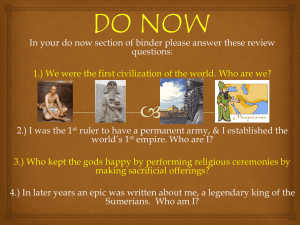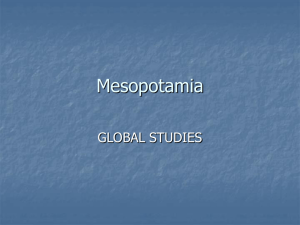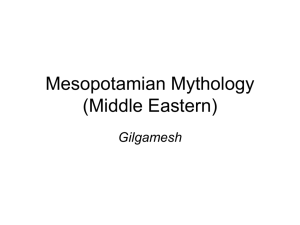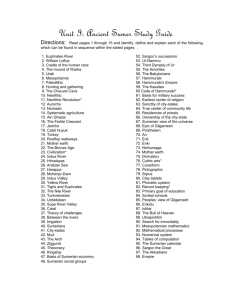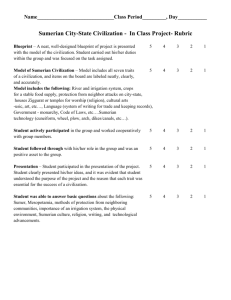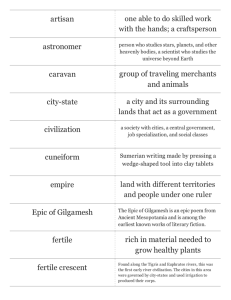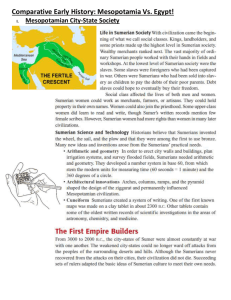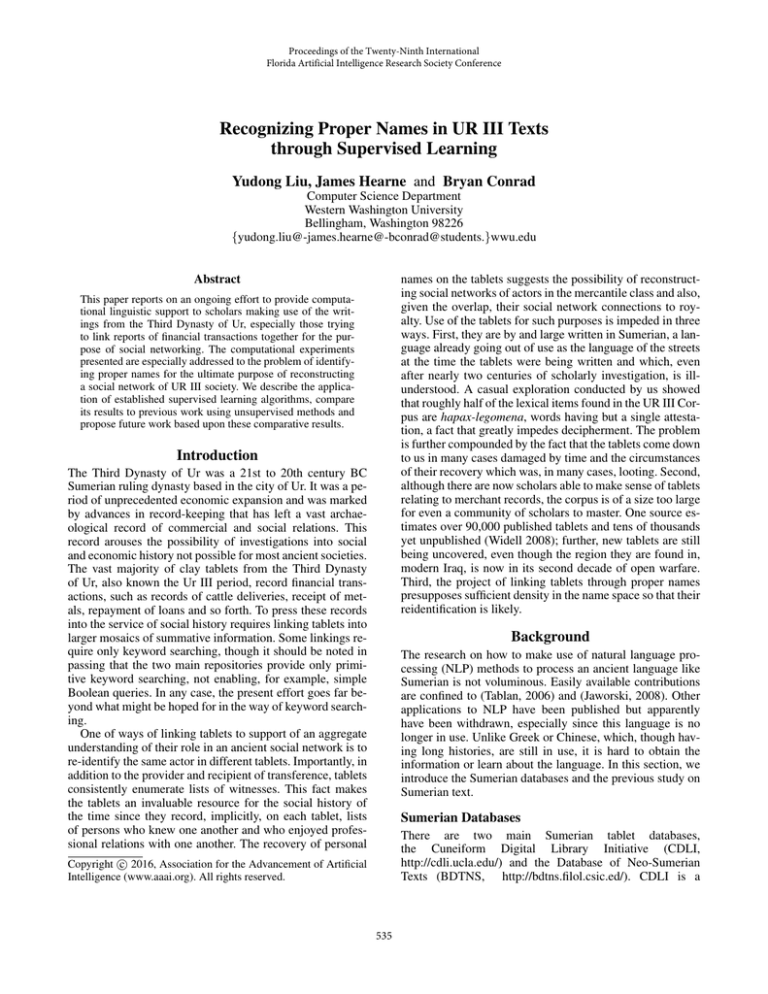
Proceedings of the Twenty-Ninth International
Florida Artificial Intelligence Research Society Conference
Recognizing Proper Names in UR III Texts
through Supervised Learning
Yudong Liu, James Hearne and Bryan Conrad
Computer Science Department
Western Washington University
Bellingham, Washington 98226
{yudong.liu@-james.hearne@-bconrad@students.}wwu.edu
names on the tablets suggests the possibility of reconstructing social networks of actors in the mercantile class and also,
given the overlap, their social network connections to royalty. Use of the tablets for such purposes is impeded in three
ways. First, they are by and large written in Sumerian, a language already going out of use as the language of the streets
at the time the tablets were being written and which, even
after nearly two centuries of scholarly investigation, is illunderstood. A casual exploration conducted by us showed
that roughly half of the lexical items found in the UR III Corpus are hapax-legomena, words having but a single attestation, a fact that greatly impedes decipherment. The problem
is further compounded by the fact that the tablets come down
to us in many cases damaged by time and the circumstances
of their recovery which was, in many cases, looting. Second,
although there are now scholars able to make sense of tablets
relating to merchant records, the corpus is of a size too large
for even a community of scholars to master. One source estimates over 90,000 published tablets and tens of thousands
yet unpublished (Widell 2008); further, new tablets are still
being uncovered, even though the region they are found in,
modern Iraq, is now in its second decade of open warfare.
Third, the project of linking tablets through proper names
presupposes sufficient density in the name space so that their
reidentification is likely.
Abstract
This paper reports on an ongoing effort to provide computational linguistic support to scholars making use of the writings from the Third Dynasty of Ur, especially those trying
to link reports of financial transactions together for the purpose of social networking. The computational experiments
presented are especially addressed to the problem of identifying proper names for the ultimate purpose of reconstructing
a social network of UR III society. We describe the application of established supervised learning algorithms, compare
its results to previous work using unsupervised methods and
propose future work based upon these comparative results.
Introduction
The Third Dynasty of Ur was a 21st to 20th century BC
Sumerian ruling dynasty based in the city of Ur. It was a period of unprecedented economic expansion and was marked
by advances in record-keeping that has left a vast archaeological record of commercial and social relations. This
record arouses the possibility of investigations into social
and economic history not possible for most ancient societies.
The vast majority of clay tablets from the Third Dynasty
of Ur, also known the Ur III period, record financial transactions, such as records of cattle deliveries, receipt of metals, repayment of loans and so forth. To press these records
into the service of social history requires linking tablets into
larger mosaics of summative information. Some linkings require only keyword searching, though it should be noted in
passing that the two main repositories provide only primitive keyword searching, not enabling, for example, simple
Boolean queries. In any case, the present effort goes far beyond what might be hoped for in the way of keyword searching.
One of ways of linking tablets to support of an aggregate
understanding of their role in an ancient social network is to
re-identify the same actor in different tablets. Importantly, in
addition to the provider and recipient of transference, tablets
consistently enumerate lists of witnesses. This fact makes
the tablets an invaluable resource for the social history of
the time since they record, implicitly, on each tablet, lists
of persons who knew one another and who enjoyed professional relations with one another. The recovery of personal
Background
The research on how to make use of natural language processing (NLP) methods to process an ancient language like
Sumerian is not voluminous. Easily available contributions
are confined to (Tablan, 2006) and (Jaworski, 2008). Other
applications to NLP have been published but apparently
have been withdrawn, especially since this language is no
longer in use. Unlike Greek or Chinese, which, though having long histories, are still in use, it is hard to obtain the
information or learn about the language. In this section, we
introduce the Sumerian databases and the previous study on
Sumerian text.
Sumerian Databases
There are two main Sumerian tablet databases,
the Cuneiform Digital Library Initiative (CDLI,
http://cdli.ucla.edu/) and the Database of Neo-Sumerian
Texts (BDTNS, http://bdtns.filol.csic.ed/). CDLI is a
c 2016, Association for the Advancement of Artificial
Copyright Intelligence (www.aaai.org). All rights reserved.
535
project that concentrates on electronic documentation of
ancient cuneiform, consisting of cuneiform texts, images,
transliterations and glossaries. It is managed at UCLA,
USA and the Max Planck Institution for the History of
Science, Berlin. BDTNS is a database that manages more
than 95,300 administrative Sumerian cuneiform tablets
during the Neo-Sumerian period.
cuneiform script is on the left; the transliteration is in the
middle and the modern English translation is on the right.
Sumerian written in cuneiform script does not have the
concept of upper- or lowercase, and as a result, in monolingual contexts, the typical step of case normalization is not
necessary as all text is rendered in lowercase in the transliteration format used by CDLI. However, signs rendered in
uppercase occur frequently and denote a number of special
circumstances, most commonly, that the phonetic equivalent of the sign is unknown. With respect to our system,
the presence of uppercase signs is rarely an issue as long
as the spelling and casing is consistently attested in the corpus. This consistency is provided by the lemmatization required of Sumerologists in order to submit initial transliterations (Foxvog 2014).
Royal epithets notwithstanding, Sumerian personal names
are exclusively comprised of a single word, almost always
consisting of at least two signs. In cases where disambiguation is required, a patronymic may added (for example, szuesz4-tar2 dumu zu-zu, “Su-Estar, son of Zuzu”). This disambiguation is frequent in practice due to the relatively shallow
pool of personal names used (Limet 1960).
Previous Work on Sumerian Texts
Research on the application of machine learning and NLP
techniques to ancient languages is not abundant. By and
large, the application of computer technology has been limited to electronic publishing and string searching. Such efforts applied to Sumerian are even more sparse. (Tablan et
al. 2006) described the creation of a tool for Sumerian linguistic analysis and corpus search applied to Sumerian literature. This work focused on the application of a morphological model for noun and verb recognition, developed by
Sumerologists. However, it did not extend beyond simple
word and morpheme recognition. (Jaworski 2008) developed an approach to extraction of information from the same
economic documents of concern to us by beginning with an
ontology of the world presupposed by this corpus and, in
conjunction with syntax and semantic analysis. The claim
of this work is that it supports research into the Sumerian
language, officials participating in the activities the tablets
record, and into document classification. Our previous work
includes (Brewer et al. 2014) and (Luo et al. 2015). Both
are addressed to the recognition of proper names in Sumerian text. (Brewer et al. 2014) uses a naive edit-distance and
pattern-matching algorithm to attempt to identify personal
names. (Luo et al. 2015) applies a DL-Cotrain based unsupervised learning method with 3 seed rules. This unsupervised method achieves a high recall (92.5%) and a low precision (56.0%). Some comparisons among these work are
described in the later section.
Lemmata
62.1% of the tablets (53,146 tablets) in the CDLI corpus are
accompanied by annotations, dubbed “lemmata” which provide, stemification, translation and categorization of linguistic elements within a line. Thus, the example given in Figure 2 gives a line of text followed by its lematization, indicated with a line-initial “#.”
In this example, the lemmatization indicates that the
word “GAN2” derives from the Sumerian stem “iku” and
is understood to mean “unit.” Similarly, “ur-{gesz}-gigir”
is a personal name; “nu-banda3” with the Sumerian stem
“nubanda” means “overseer”, a common profession in
Sumerian society; the word “gu4” with the Sumerian stem
“gud” means “ox.” Sometimes, when the function of a work
is uncertain, the lemmatization offers more than one category. For example, the lemma “GN|FN” indicates that the
corresponding can be either a geographical name or the
name of a field (analogous the “Potter’s Field.”).
Data of CDLI
In this project, we still use the CDLI repository as we did
in our previous work for its restriction to the ASCII character set is more convenient than the UTF-8 encoding used by
BDTNS, as well as for comparison purpose. Of this repository we use the 53,146 tablets having lemmata.
In the following, we will give more detailed introduction
of the CDLI data.
Damaged Tablets
In CDLI corpus, some transliterations have “[” and “]” attaching to a sign. It indicates the sign is damaged. More
specifically, “[” indicates that the following sign is damaged
on the left edge, whereas “]” indicates the following sign
is damaged on the right edge (Sahala 2012). “[x]” indicates
that there is a sign that cannot be read due to the damage on
both edges and “[...]” indicates that there are several unreadable signs.
CDLI: Words and Signs
Although the texts we are investigating were originally
written in cuneiform script, scholars have traditionally
worked with transliterations using the English alphabet. Homophony, which is very common in cuneiform, is handled
by numerical subscripts, i.e., “gu,” “gu2 ” and “gu3 ” refer
to distinct signs with the same sound value. Sumeriologists
have developed a system of in-text annotations important to
the application of NLP techniques.
Figure 1 shows the tablet with an id of P105955
from CDLI repository ( http://cdli.ucla.edu/). The original
Supervised Proper Name Recognizer
An important task in supervised learning is to propose a
set of useful features. Because there is no previous work as
such, we proposed a set of features that capture either the
context or the spelling of the word of interest. We reported
the system performance of a variety of supervised learning
536
Figure 1: Tablet with ID of P105955 from CDLI.
only words with damage the transliterators judged was minor enough that they could still make a reasonable assertion
about what the word was (and it’s part of speech) were allowed. There are 447,995 examples in the test set 2, which
indicate the 4,731 examples that are not in test set 1 but in
test set 2 are words that contain damaged signs.
Figure 2: A lemmatized transliteration.
strategies. These learning strategies did not show much difference in performance. We also compared our supervised
learning result with the unsupervised learning result reported
in (Luo et al. 2015), and gave some discussion. In the following, we will describe the system in more details.
Features
For each word in the corpus, the presence or absence of 36
features was recorded. The majority of the features are either context-related features such as the word or its part-ofspeech tag to the left or the right of the current word, or
the spelling features such as if the current word contains a
certain sign or a certain part-of-speech tag (such as “profession”). Other features include the positional information
about the current word in the current line, the repetitive occurrences of certain signs in the current word and if the
current word is the only word of the line. The contextual
features and spelling features are mostly overlapped with
the contextual rules and spelling rules learnt from the DLCotrain method in (Luo et al. 2015). Table 1 enumerates
these features.
Data
To utilize the pre-knowledge from the language experts
and (Weibull 2004), we apply a tag set of 13 tags to preannotate the corpus. The 13 tags in the tag set {“GN”, “FN”,
“TN”, “WN”, “MN”, “n”, “TITLE”, “UNIT”, “GOODS”,
“OCCUPATION”, “YEAR”, “MONTH”, “DAY”} represent geographical names, field names, temple names, watercourse names, month names, numbers, title names, unit
names, trade goods names, occupation names and indicators
for year, month and day, respectively. In the following, we
call such tags “part-of-speech tags”.
For the purposes of this work, the Ur III corpus was divided into a number of subsets. The training set, used to
train all our machine learning models, consisted of 80% of
the portion of the corpus for which there were reliable partof-speech tags. All lines which contained any damage to the
words were then removed, so as to be as certain as possible that the features and labels the models were trained with
were accurate. As a result, there are 1,788,627 training examples in total of which 9.5% are positive examples and the
rest are negative examples.
The remaining 20% of the labelled corpus was used for
two different test sets. Test set 1 consisted entirely of lines
containing no damage. In total we have 443,264 examples
in the test set 1. Test set 2 contains all of set 1, along with
some lines (about 10,000) with some damage. However,
Supervised Learning
Seven machine learning algorithms were chosen for this
work, all of which implemented by sci-kit learn (Pedregosa
et al. 2011). Each implementation has a number of options
for customizing its performance, such as learning rate and
number of training iterations. The values for these parameters were chosen by first selecting a list of reasonable values for each option, then for each combination of values a
model was trained, and the model giving the best accuracy
was kept. The algorithms are:
1. Decision Tree Classifier: A single decision tree constructed with a version of the Classification and Regression Trees (CART) algorithm, using information gain
(Kullback-Leibler divergence) to determine the optimal
splits.
537
word index in line. 0-indexed.
left context. None if this is the first word in the line.
right context. None if this is the last word in the line.
line context. All words in line, space-delimited.
if word is alone on line.
if left context is dumu (“child (of)”).
%This may suggest a personal name in a patronymic.
if right context is dumu (“child (of)”).
if line context is kiword.
%This may suggest a seller in a transaction.
if line context is igi word.
%This may suggest a witness to a transaction.
if line context is igi word-sze3.
%This may suggest a witness to a transaction.
if line context is the Personnenkeil 1(disz) word.
%This may suggest a list of named individuals.
if line context is kiszib3 word.
%This may suggest the individual responsible for sealing
%a tablet.
if line context is giri3 word.
if first sign in word is repeated.
%Sumerian names tend to favor repeated syllables.
last sign in word is repeated.
if any sign in word is repeated.
if word is a common profession.
if word contains a profession.
if left context is a profession.
if left context contains a profession.
if right context is a profession.
if right context contains a profession.
if word starts with ur.
if word starts with lu2-.
if word ends with -mu.
if word contains {d}.
%short for “dingir”(“deity”), the divine determinative.
if word contains {ki} “place”.
if word contains any determinative.
if word’s transliteration contains the letter q.
if word contains lugal (“king; large”).
if word contains a number.
if word followed by sag.
if word followed by zarin.
if word followed by a numeric classifier.
if line context begins with iti (“month”).
if line context begins with mu (“year”).
given the weighted sum of the input features, gives results
close to 1 when the true class is “positive” or “success”
(In the case of this work, a personal name) and close to 0
otherwise.
4. Naive Bayes: Makes use of Bayes Theorem to train a simple classification model. Starts with the observed data (including the distribution of names/non-names in the training set), and calculates the most probable class for each
word. Despite the assumption that the features are all conditionally independent given the true class, Naive Bayes
has enjoyed some success as a classification tool.
5. Stochastic Gradient Descent (SGD): Does Stochastic Gradient Descent (i.e. updates the gradient of the loss with
each instance examined, rather than averaging it across
all instances in the training set) on a logistic regression
model.
6. Linear Support Vector Machine: Support Vector Machines try to discover a hyperplane across the set of features that divides the data points in the “personal name”
class from the others or, if it cannot, to find a hyperplane
that misclassifies as few points as possible (called a soft
margin).
7. Random Forest Classifier: A collection of 500 decision
trees, trained on different subsets of the data and combined to form a stronger classifier. Each tree contributes
its estimation of the probabilities of the different output
classes to the final result.
Results
For the most part, the results obtained from the different algorithms were quite similar, though there were some interesting patterns.
Method
Decision Tree
Gradient Boosting
Logistic Regression
Naive Bayes
Gradient Descent (SGD)
SVM
Random Forest
Precision
0.898
0.872
0.858
0.831
0.864
0.856
0.932
Recall
0.475
0.660
0.662
0.611
0.653
0.655
0.458
Fscore
0.621
0.752
0.748
0.704
0.744
0.742
0.614
Table 2: Test Set 1 - data with no damaged words
Table 1: 36 features applied in training data and test data
Method
Decision Tree
Gradient Boosting
Logistic Regression
Naive Bayes
Gradient Descent (SGD)
SVM
Random Forest
2. Gradient Boosting Classifier: Combines 500 weak regression trees using a logistic regression loss function into a
stronger classifier. This is done in sequence, with each
each trees contribution to the overall result being smaller
than the size of the previous one by the learning rate,
which is 10%.
3. Logistic Regression: Training a logistic regression model
consists of using Maximum Likelihood Estimation to find
a series of weights such that the logistic function, when
Precision
0.899
0.873
0.859
0.832
0.864
0.857
0.933
Recall
0.474
0.658
0.660
0.609
0.650
0.653
0.458
Fscore
0.621
0.750
0.746
0.703
0.742
0.741
0.614
Table 3: Test Set 2 - data with damaged words
538
Conclusion and Future Work
Each classifier produced very similar results on both data
sets. This indicates that the damaged signs that can be annotated in the lemmata are also easy for the machine to recognize through the context or the spelling components. It
would be interesting to see how the system works on the
damaged signs that are not initially marked in the lemmata.
However the evaluation on such data set would be more challenging given that it would involve more human expertise.
The Decision Tree classifier and the Random Forest classifier (which was constructed from multiple decision trees)
both traded low recall for a higher precision to a greater extent than the others, in particular the Random Forest, which
had both the highest precision and lowest recall of all the
algorithms. Of the others, the Gradient Boosting classifier,
Logistic Regression, Stochastic Gradient Descent, and the
Support Vector Machine all produced very similar results.
The Naive Bayes classifier, on the other hand, does not seem
to be the best model for this task, at least as used here. It had
the lowest precision, at 83%, and the lowest recall after the
models involving decision trees, at 61%.
The similarity between the results of different methods
raised suspicions that they were learning very similar models, and that many words labeled correctly as personal names
were identified by all or most of the algorithms. To test this,
a system was set up in which each algorithm’s label for a
word was interpreted as a ‘vote’ that that class be assigned
to that word, and each word was classified according to the
label that received the most votes across all methods. This
conjecture seems to be confirmed, although more investigation is still under way; the resulting system achieved a recall
of 65% and precision of 86% on both test sets.
In this paper we reported our ongoing work on a supervised
proper name recognizer of the Sumerian corpus of CDLI
database.
As the first work of applying supervised method on Sumerian proper name recognition, our major contribution is twofold. One is in feature selection. With the result from our
previous work on unsupervised learning on this task, and
with the help from a domain expert in our home university, we proposed a set of 36 features for both training and
testing. The experiments have shown that different machine
learning methods, when exploiting these features, can perform with high precision, which indicates the features are
accurate enough to predict true names. Secondly, our work
shows that the decision tree based method is not the best option in this setting, which indicates that the combinations of
features are more predictive of the class label in this application. However the decision tree do not provide such information. The relative poor performance of the Naive Bayes
method may be due to the fact that some of the features here
are more correlated with each other. Other machine learning
methods gave very similar result and performance. In comparison with the previous work on unsupervised Sumerian
proper name recognition (Luo et al. 2015), it suggested that
the current feature set is accurate but not large enough. How
to obtain a richer feature set, compare to the adoption of a
machine learning strategy, is more important for this task.
For the future work, we would like to do a more in-depth
comparison between the features we proposed here and the
rules resulting from the unsupervised method. We believe
that it would help to further incorporate good features. It
would also be interesting to do analysis of the relevance of
the features. More feature engineering and analysis would
tell us what types of features are more salient and worth exploring. Since our work has drawn more attention from the
Assyriologists across the world, we have been provided a
richer set of features on this task. In addition, our experimental results showed that some methods tend to favor precision , while others recalls. We need to do more exploration
on how the training process and parameter optimization affected the results, and see if the process has been sufficiently
optimized.
Comparison with the Unsupervised Method
(Luo et al. 2015) reported a DL-CoTrain based unsupervised Proper Name Recognizer for CDLI data set. With 3
seeds rules and 150 iterations, this system generated over
2,000 decision rules, and achieves a high recall (92.5%) and
a low precision (56.0%), which means it produces a lot of
false positives. This indicates that a subset of these over
2,000 rules are accurate enough that it predicts most of the
true names. However it also generates a lot of rules which
are not accurate enough that 44% of the names it predicts
are not labelled as names by the annotators.
In the supervised setting, the system exhibits opposite behaviors. It achieves a low recall (around 65%) but a high
precision (around 86%), meaning that the supervised system
can predict a name with a high accuracy but is not competent
enough to identify much more than a simple majority of the
names. This may be due to the fact that the features used are
very good ones when they apply but their number and variety are insufficient to provide full coverage. Thus, we need
a larger feature set.
Some of the 36 features in the current supervised setting are selected from the high confident contextual rules
and spelling rules generated by the DL-Cotrain method. One
possible way to improve the current supervised learning result is to include more features from the decision list of DLCotrain.
Acknowledgments
The authors wish to thank Steven Garfinkle from Department of History of Western Washington University, and Mr.
Clinton Burkhart for their assistance and valuable input as a
language expert in this work.
References
Brewer, F.; Burkhart, C.; Houng, J.; Luo, L.; Riley, D.;
Toner, Brandon. Liu, Y.; and Hearne, J. 2014. A preliminary
study into named entity recognition in cuneiform tablets.
In The third Pacific Northwest Regional Natural Language
Processing Workshop, 1–3.
Foxvog, D. 2014. An introduction to sumerian grammar.
539
Jaworski, W. 2008. Contents modeling of neo-sumerian ur
iii economic text corpus. In Proceedings of the 22nd International Conference on Computational Linguistics, 369–376.
Limet, H. 1960. L’Anthroponymie sumerienne dans les documents de la 3e dynastie d’Ur. Paris: Socit d’dition Les
Belles Lettres.
Luo, L.; Liu, Y.; Hearne, J.; and Burkhart, C. 2015. Unsupervised sumerian personal name recognition. In Proceedings
of the Twenty-Eighth International Florida Artificial Intelligence Research Society Conference, FLAIRS 2015, Hollywood, Florida. May 18-20, 2015., 193–198.
Pedregosa, F.; Varoquaux, G.; Gramfort, A.; Michel, V.;
Thirion, B.; Grisel, O.; Blondel, M.; Prettenhofer, P.; Weiss,
R.; Dubourg, V.; Vanderplas, J.; Passos, A.; Cournapeau, D.;
Brucher, M.; Perrot, M.; and Duchesnay, E. 2011. Scikitlearn: Machine learning in Python. Journal of Machine
Learning Research 12:2825–2830.
Sahala, A. 2012. Notation in sumerian transliteration. Technical report, University of Helsinki.
Tablan, V.; Peters, W.; Maynard, D.; and Cunningham, H.
2006. Creating tools for morphological analysis of sumerian. In Proceedings of the Fifth International Conference
on Language Resources and Evaluation, 1762–1765.
Weibull, N. 2004. A historical survey of number systems.
Technical report, Chalmers University of Technology.
Widell, M. 2008. The ur iii metal loans from ur. In Garfinkle,
S., and Cale Johnson, J., eds., The Growth of an Early State
in Mesopotamia: Studies in Ur III Administration. Madrid:
Consejo Superior de Investigationes Cientficas. 207–223.
540

